Technologies and Products
Please request SDS and various certificates through a trading company or other purchasing channels.
This section introduces Asahi Kasei's material solutions for safer and lighter EV battery packs
2021.03.24
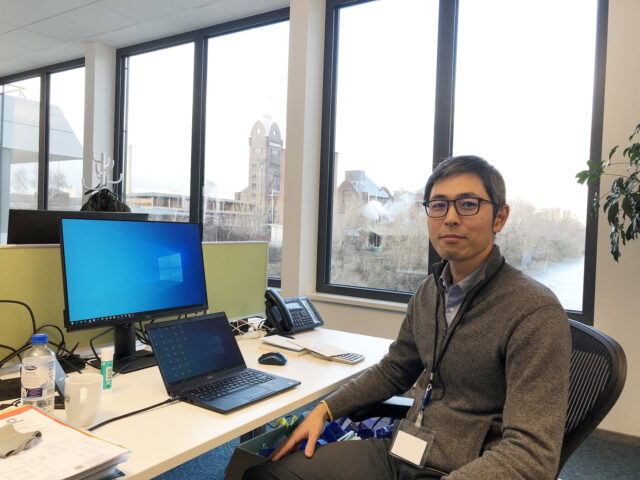
Interviews
In the context of “Green Recovery” as an economic restoration measure from the COVID-19, the development of electric vehicles is accelerating. Asahi Kasei is known as a leading provider of lithium-ion battery separators, and is now proposing also engineering plastics and highly innovative technical particle foams for automotive battery applications. Together with the Austrian engineering company AVL List GmbH (AVL), Asahi Kasei started a joint EV battery concept, bringing together the company’s broad variety of materials and technologies. We interviewed Hirofumi Samuta of Asahi Kasei Europe (AKEU), the driving force behind this project about the background and market response of this project, as well as about his vision for the future of EV batteries.
 ▲Hirofumi Samuta, Asahi Kasei Europe (AKEU). At the office in Dusseldorf, Germany.
▲Hirofumi Samuta, Asahi Kasei Europe (AKEU). At the office in Dusseldorf, Germany.
“I was assigned to AKEU (Dusseldorf, Germany) in 2017. Asahi Kasei has a broad range of highly innovative materials but raising our overall presence and finding the right approach to establish relationships with the European car manufacturers and Tier-1 suppliers proved to be a major challenge. We soon decided to take a cross-material system approach, proposing various materials including our engineering plastics in a conceptual EV battery pack.
At that time the EV market started to rapidly expand, and it soon became clear that this huge task could not be covered by OEMs and Tiers alone. The conventional and traditional structures in the automotive industry were already starting to break up, with the OEMs becoming more open to also communicate directly to material suppliers. By proposing a new battery pack concept in this situation, I felt that we could raise a lot of attention on the market.
” To achieve this, we decided to bring in some extra expertise from outside. Working together with external engineering providers is quite common in Europe. AKEU chose AVL, which has a high reputation in the field of batteries including research and experiments, as a partner in order to approach the market the European way. We received great support from AVL in a technical way to finally complete the verification and design.”
“The concept battery pack mock-up was completed in 2018 and we presented if for the first time publicly at the Advanced Automotive Battery Conference (AABC) in January 2019. Needless to say, the attention was high, and many visitors to our booth were highly interested in our choice of materials for the various pack components.
The AABC became the first occasion to present the concept, followed by many others in the months to come.
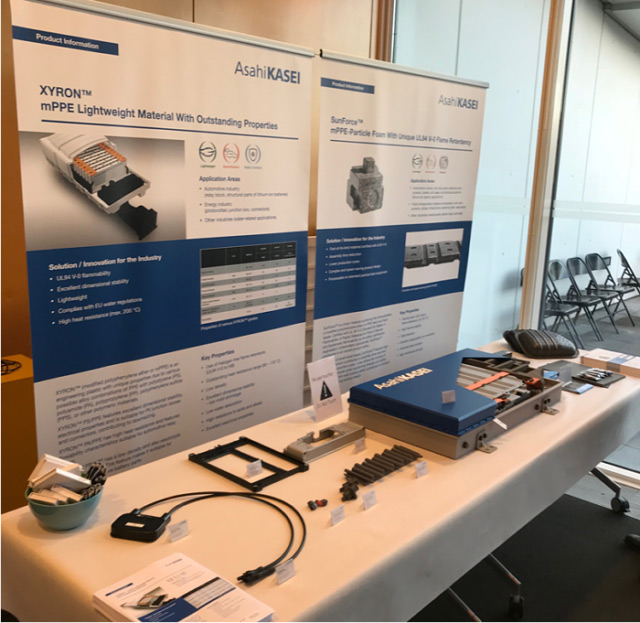 ▲The battery pack concept at a customer presentation
▲The battery pack concept at a customer presentation
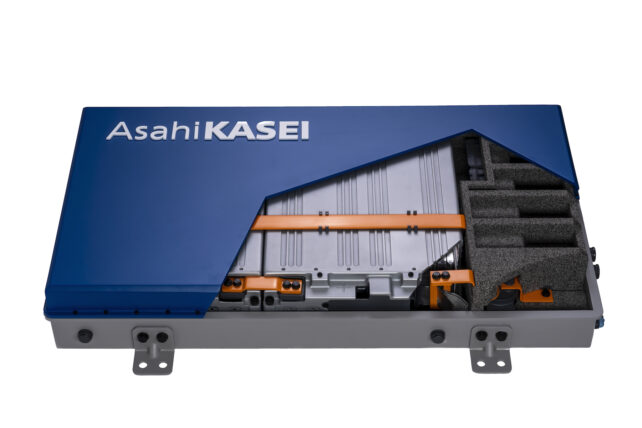 ▲The concept battery pack
▲The concept battery pack
“The key features of our concept are its lightweight and safety. Conventional battery packs are usually very heavy, our lightweight concept can help to reduce CO2 emissions and ultimately contribute to a more sustainable approach. The materials we use are XYRON™, SunForce™ and LEONA™. XYRON™ is an engineering plastic that is extremely light and has flame retardant properties, which highly add to safety. SunForce™ is a unique particle foam material. Based on XYRON™, it shares the same properties in regard to lightweight and flame retardancy.
In addition
it comes with a high designability and dimensional stability, allowing for thin-wall molding and a broad variety of shapes. LEONA™ is a very strong engineering plastic that can replace metal to reduce weight.”
・XYRON™, a modified polyphenylene (m-PPE) resin with the smallest specific gravity among engineering plastics, offering excellent dimensional accuracy, flame retardancy, and insulation properties, high barrier properties, and extended battery life (available at the New Site URL)』
SunForce™, an m-PPE based engineering plastic foam with excellent dimensional accuracy, flame retardancy, and heat resistance that combines functions that exceed those of conventional foams (available at the New Site URL)』
・LEONA™, a polyamide resin with a wide range of lineups by compounding various fillers and polymers and realizing metal replacement through high strength, high rigidity, etc. (available at the New Site URL)』
These materials not only contribute to lightweight and safety, but raise the overall battery performance, mass productivity, multiple parts integration, etc.
“As a material supplier it is crucial to not only understand your own materials, but also the applications they eventually will be used in. Without having this understanding, your material development will never match the actual customer needs.
This was also one reason why we started the “Battery Project”, to gain a thorough understanding about the various parts of a battery, the properties and functions they need to cover. It ultimately helped us to properly understand our customer’s pain points. We actually went through the process of assembling each part into the final product by ourselves, and the more we understood, the more we found things we didn’t understand. This process helped us tremendously to make the right proposals to our customers.”
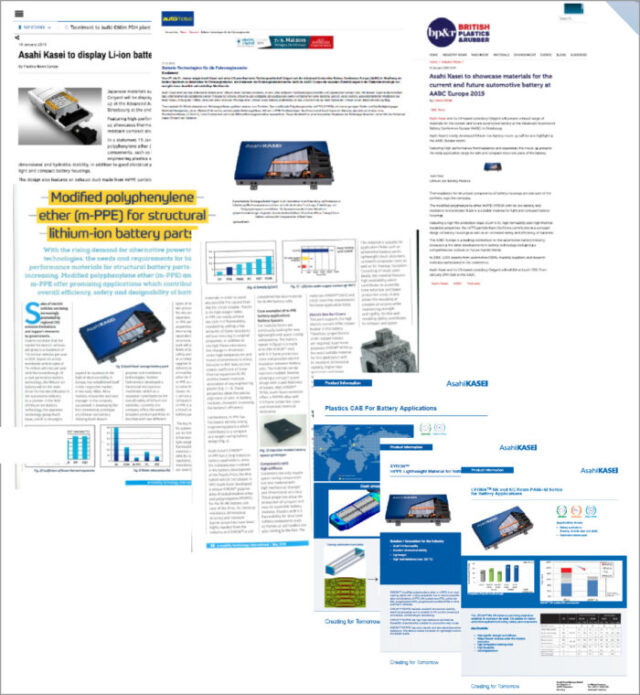 ▲The Battery Project was covered in a variety of magazines and media
▲The Battery Project was covered in a variety of magazines and media
“Through the “Battery Project,” we have been able to start development projects with OEMs and Tier 1 companies, and we feel very satisfied with the results. We are now in the process of developing a new grade in collaboration with our customers.
Personally, this project has helped me to expand my personal network and build relationships that allow me to exchange information. I have been able to connect with people from various business units, marketing and business development people, and people in the U.S. For example, there have been times when other business units have approached AKEU and said, “We have a customer who is having trouble with a product, and we would like to introduce it to you.” Asahi Kasei has a large lineup of products and is engaged in a variety of businesses, so even if a problem cannot be solved with resin, it can be solved with other technologies.”
“The biggest goal for the future is the creation of actual products based on the Battery Project. Conducting joint development with external partners and customers is a new approach for Asahi Kasei. But it helped a lot and we are eager to further broaden our horizon by providing our material expertise and continuously deepen our understanding of applications.
The awareness towards sustainability is accelerating worldwide. Proposing solutions to reduce CO2 emissions and achieve carbon neutrality while at the same time working on the recyclability of our own products is a major challenge for automotive suppliers worldwide. The Battery Project showed that our lightweight materials can help to reduce the overall CO2 emissions of a battery pack throughout its life cycle. Our next challenge is to work on the materials themselves, making them recyclable and more sustainable in general.
From packs with several battery modules to packs without any modules, or new batteries like the solid-state battery: Technological innovation is constantly taking place in the field of battery technology. By constantly taking the “application point of view”, we will continue to closely collaborate with our customers, proposing the right material for the right application.
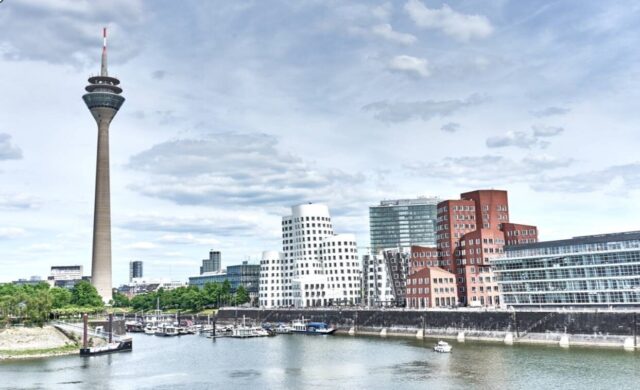 ▲Scenery of Dusseldorf, Germany
▲Scenery of Dusseldorf, Germany
Due to the ongoing COVID-19 pandemic, the AABC exhibition in January 2021 was held virtually, and this interview was also held during an ongoing lockdown in Dusseldorf. The pandemic has made us keenly aware that our daily lives are connected to the global world, but we may also be able to find solutions to familiar social issues by connecting with people and gathering knowledge from a global perspective. The “Battery Project” continues while responding to changes. We will devise ways to present our concepts, deepen our understanding of our products, and commit ourselves to the market. We also consider what Asahi Kasei can do to address the issues and problems of our customers and propose solutions. This is only the start, and we are looking forward to the future.
Asahi Kasei's engineering plastics products and technologies I'll introduce you in more detail.